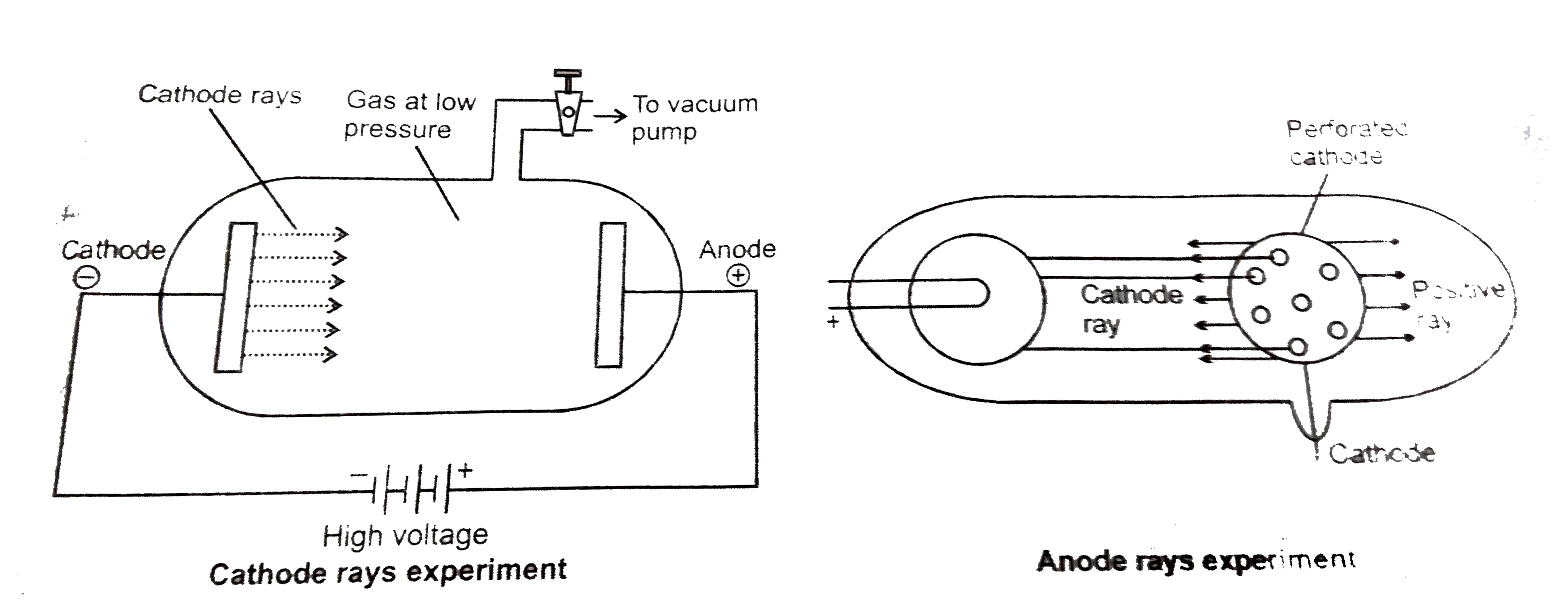Which postulate of the cathode ray tube experiment shows that these rays comprise of negatively charged particles?
To answer the question about which postulate of the cathode ray tube experiment shows that cathode rays comprise negatively charged particles, we can follow these steps:
1. Understanding Cathode Rays:
- Cathode rays are streams of electrons emitted from the cathode (negative electrode) in a vacuum tube.
2. Application of Electric Field:
- When a cathode ray beam is subjected to an external electric field, it experiences a force due to the field.
3. Observation of Deflection:
- In the experiment, it is observed that the cathode ray beam deflects towards the positive plate when the electric field is applied.
4. Conclusion about Charge:
- The deflection towards the positive plate indicates that the particles in the cathode ray are negatively charged. This is because opposite charges attract; hence, the negatively charged particles (electrons) are attracted to the positive plate.
5. Postulate Identification:
- The postulate that states that the cathode ray beam deflects towards the positive plate when an electric field is applied demonstrates that cathode rays consist of negatively charged particles.
Final Answer:
The postulate of the cathode ray tube experiment that shows these rays comprise negatively charged particles is that the cathode ray beam deflects towards the positive plate when subjected to an externally applied electric field.
---
- Cathode rays are streams of electrons emitted from the cathode (negative electrode) in a vacuum tube.
- When a cathode ray beam is subjected to an external electric field, it experiences a force due to the field.
- In the experiment, it is observed that the cathode ray beam deflects towards the positive plate when the electric field is applied.
- The deflection towards the positive plate indicates that the particles in the cathode ray are negatively charged. This is because opposite charges attract; hence, the negatively charged particles (electrons) are attracted to the positive plate.
- The postulate that states that the cathode ray beam deflects towards the positive plate when an electric field is applied demonstrates that cathode rays consist of negatively charged particles.
The postulate of the cathode ray tube experiment that shows these rays comprise negatively charged particles is that the cathode ray beam deflects towards the positive plate when subjected to an externally applied electric field.
Topper's Solved these Questions
- STRUCTURE OF ATOMBook:VMC MODULES ENGLISHChapter:STRUCTURE OF ATOMExercise:IN-CHAPTER EXERCISE-A
Explore 10 Videos
- STRUCTURE OF ATOMBook:VMC MODULES ENGLISHChapter:STRUCTURE OF ATOMExercise:IN-CHAPTER EXERCISE-B
Explore 9 Videos
- STRUCTURE OF ATOMBook:VMC MODULES ENGLISHChapter:STRUCTURE OF ATOMExercise:Example
Explore 19 Videos
- STOICHIOMETRY-IIBook:VMC MODULES ENGLISHChapter:STOICHIOMETRY-IIExercise:JEE Advanced (Archive)
Explore 43 Videos
- SURFACE CHEMISTRYBook:VMC MODULES ENGLISHChapter:SURFACE CHEMISTRYExercise:PRACTICE EXERCISE
Explore 9 Videos
Similar Questions
Knowledge Check
Assertion : The characteristics of cathode rays do not depend upon the material of electrodes and the nature of the gas present in the cathode ray tube.
Reason : Cathode rays consist of negatively charged particles, called electrons.AIf both assertion and reason are true and reason is the correct explanation of assertion.BIf both assertion and reason are true but reason is not the correct explanation of assertion.CIf assertion is true but reason is false.DIf both assertion and reason are false.
State two uses of a cathode ray tube.
View SolutionWhich of the following scientists observed that cathode rays consist of negatively-charged particles?
View SolutionJ.J. Thomson's cathode-ray tube experiment demonstrated that
View SolutionWhy cathode ray tube experiment is not conducted at atmospheric pressure?
View SolutionWhich rays contain (+ Ve) charged particle : -
View SolutionWhich is not true with respect to the cathode rays ?
View SolutionThe existence of negatively charged particle in an atom was shown by J.J. Thomson as a result of the studies of the passage of electricity through gases at extremely low pressure known as discharge tube experiments. When a high voltage of the order of 10,000 volts or more was impressed across the electrodes, some sort of invisible rays moved from the negative electrode to the positive electrode these rays are called as cathode rays.

Cathode rays travel in straight path in absence of electrical and magnetic field . Cathode rays consist of material part and charged particles? Cathode rays produce X-rays and light is emitted when they strike on ZnS screen. Cathode rays penetrate through thin sheets of aluminium and other metals . They affect the photogenic plate and passes heating effect when they strike on metal foil. The raito of charge to mass i.e charge/mass is same for all the cathode rays irrespective of the gas used in the tube.
The existence of positively charged particle in an atom was shown be E. Goldstein. He repeated the same discharge tube experiments by using a perforated cathode. It was observed that when a high potential difference was applied between the electrodes, not only cathode rays were produced but also a new type of rays were produced simultaneoulsy from anode moving towards cathode and passes through the holes or canal of the cathode. These termed as canal rays or anode rays.
These rays travel in straight lines and consists of positively charged particles. These rays have kinetic energy and produces heating effect also. The e/m ratio of these rays is smaller than that of electrons. Unlike cathode rays, their e/m value is dependent upon the nature of the gas taken in the tube. These rays produced flashes of light on ZnS screen and can pass throughs thin metal foils. They can produce physical and chemical changes and are capable to produce ionisation in gases.
Which is not true with respect to cathode rays?
View Solution